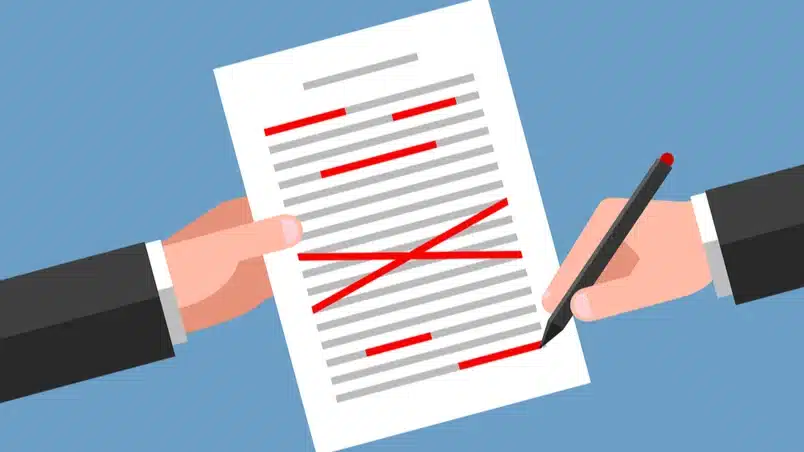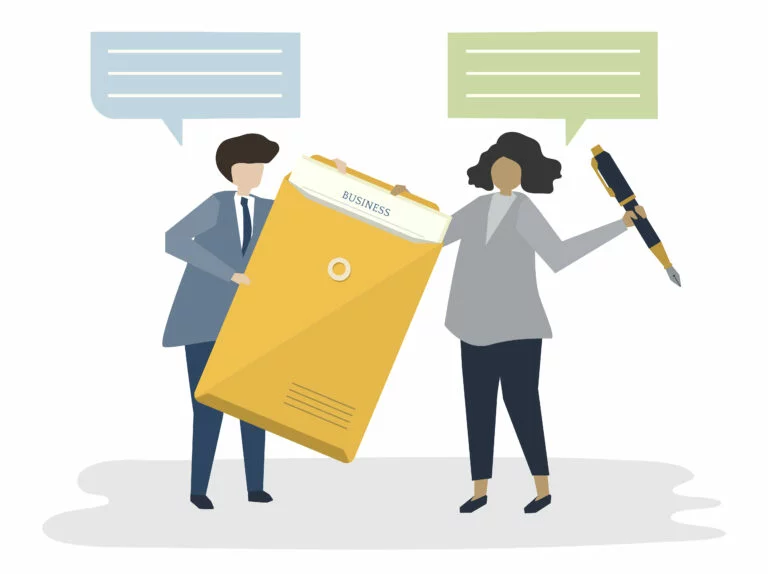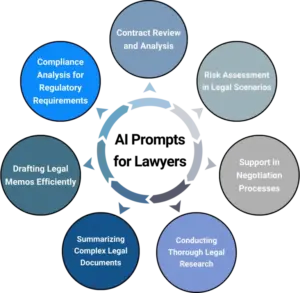In the complex world of contract management, understanding key processes like redlining and template usage is essential for efficiency and accuracy. This article delves into the fundamentals of contract redlining, explaining how it streamlines negotiations and ensures clarity. Additionally, it explores the significance of contract templates in standardizing agreements and discusses on how to reduce contract redlining. Discover how these practices can revolutionize contract management for businesses of all sizes.
Understanding Contract Redlining

Contract redlining is the process of reviewing and revising contract terms between parties before finalizing a deal. It involves marking proposed changes using tools like track changes in word processing software.
Redlining ensures all stakeholders understand and agree on the terms, leading to a smoother negotiation process. Legal teams use this method to clarify ambiguous clauses, ensure enforceability, and enhance clarity in contracts. By streamlining the editing and formatting of legal documents, redlining promotes consistency and reduces the risk of misunderstandings.
Redlining in the Digital Age
In today’s digital world, redlining means editing and updating contract documents using features like tracking changes in software such as Microsoft Word or Google Docs. This lets people work together and make changes to a contract as needed, right on the computer screen. Redlining involves showing new parts, removing old ones, and adjusting how things look to make sure everything makes sense and can be enforced.
Automating this process saves time, makes sure things are consistent, and reduces any confusion about what the contract means. It’s a really important part of managing contracts nowadays.
Why Redlining is a Crucial Step in Contract Management?
Redlining is a pivotal phase in the contract negotiation process. By scrutinizing and revising contract terms, redlining ensures legal clarity and conformity with business terms. It allows stakeholders to iron out ambiguities, enforceability issues, and formatting inconsistencies before finalizing the document.
During redlining, which is like editing a document, people involved in the contract process can change or delete parts of the contract to make it easier to read and work with. This careful editing ensures that when the contract is finished, it says what both sides want it to say. This helps avoid disagreements later on and makes sure the agreement is clear and can be enforced.
Related Article: Master Contract Redlining: What Is It And How To Do It?
What Causes High Redlining Rates?

High redlining rates can be caused by several factors in the contract negotiation process.
- Ambiguous Terms: When the words in a contract are not clear or can mean different things, it often causes lots of changes as people try to make them easier to understand.
- Poor Communication: When people don’t understand or agree on important words, they might need to change things a lot to agree with each other.
- Complex Terms: Unfamiliar or complicated contract terms can result in more revisions as parties seek clarity.
- Inefficient Processes: Poorly managed contract workflows can lead to delays, miscommunication, and multiple revisions.
Overall, high redlining rates are often a result of misalignment, ambiguity, and inefficiencies in the contract negotiation process. By addressing these factors and implementing strategies such as using contract templates, businesses can reduce redlines and improve efficiency in contract negotiations.
Related Article: Negotiating Adhesion Contracts: Contracts That Stick!
The Role of Contract Templates in Simplifying Redlining

Contract templates play a crucial role in simplifying redlining processes by providing a standardized framework for negotiations. These templates streamline the drafting process, ensuring consistency in contract terms and reducing errors. By using predefined clauses and language, legal teams can expedite the redlining process and minimize misunderstandings. Using this standard method not only saves time but also makes contract management better by setting up a clear way to check and finish contracts.
How Templates Streamline the Drafting Process?
Contract templates are super important because they help make writing contracts easier. They give a clear plan to make agreements quickly. These templates already have some contract parts written, which can be changed to fit what’s needed.
This saves time and makes sure everything stays the same. By utilizing templates, legal teams can expedite the contract creation process, reduce errors, and standardize agreements across the organization. This systematic approach enhances workflow efficiency and increases overall productivity in contract management.
Reducing Errors and Misunderstandings Through Standardization
By implementing standardized contract templates, businesses can significantly reduce errors and misunderstandings in their agreements. Standardization ensures that all contracts follow a consistent format and use clear, predefined language.
This helps in minimizing ambiguity and confusion during the negotiation process and contract redlining. When companies use templates to make contracts simpler and organize them better, it helps make things clearer, and easier to enforce and keeps everything the same in all legal papers. This means fewer errors and contracts move along more smoothly.
Related Article: Contract Templates Standardization: Simplifying Legal Work
How to Use Contract Templates to Reduce Redlines?

Using contract templates is an effective way to reduce redlines in the negotiation process. Here are some key steps to use contract templates effectively:
- Identify the types of contracts that are frequently negotiated and redlined in your organization. These can include sales contracts, vendor agreements, or employment contracts.
- Communicate the use of contract templates to all relevant parties, including legal teams, department heads, and stakeholders involved in the negotiation process. Provide training and guidelines on how to utilize the templates effectively.
- Develop standardized contract templates for these types of contracts. These templates should include all necessary terms and conditions, as well as any optional clauses that can be customized as needed.
- Encourage the use of contract templates as the starting point for negotiations. Parties should review and propose changes within the framework of the template, focusing on specific areas that require customization rather than revising the entire contract.
- Use clear and concise language in the contract templates to minimize ambiguity and the need for extensive revisions. Include explanatory comments or guidance within the template to provide additional context for key terms.
Related Article: Legal Playbook: Essential Reasons Why Your Business Needs One
Advantages of Implementing Contract Templates

Speeding up contract creation and review is a significant advantage of implementing contract templates. By using standardized templates, organizations can ensure consistency across all documents, reducing the risk of errors and misunderstandings. Enhanced efficiency in drafting contracts helps in faster deal closures and minimizes the chances of contract disputes. Moreover, the systematic approach facilitated by templates leads to a more streamlined contract management process, benefiting legal departments and business leaders alike.
Speeding Up Contract Creation and Review
Using contract templates makes creating and reviewing contracts much faster. These templates give a strong structure with important terms and clauses already included, which helps speed up negotiations and means there’s less need for big changes.
Teams can quickly make contracts using the set language and structures in the templates, so deals happen faster. This not only saves time but also makes businesses more productive, letting them finish deals quicker while still being accurate and following the rules. Using templates to make these processes smoother is a smart choice for any business that wants to work more efficiently.
Enhancing Consistency Across All Documents
Using contract templates is important for making sure all documents look and sound the same. This means using the same words, style, and important parts in every contract. When everything looks the same, it’s easier to check and there are fewer mistakes.
Having set templates also makes sure everyone understands what’s in the contract and keeps the legal terms the same. This helps make contract work go smoother and faster for everyone involved.
Lowering the Risk of Contract Disputes
Using contract templates helps organizations avoid contract arguments. These templates make sure contract terms are clear, reducing the chance of misunderstandings between people. When contract language is consistent, it lowers mistakes and confusion that might cause fights.
This active way not only saves time fixing arguments but also makes contracts stronger. By making things easier and talking clearly, contract templates help reduce the risks of contracts causing problems.
Related Article: How To Accelerate Contract Review Process? An Effective Guide
Overcoming Common Template Implementation Challenges

Implementing contract templates can come with its own set of challenges. It is important to be aware of these challenges and develop strategies to overcome them. Here are some common challenges and how to address them:
- Keeping Templates Updated: Regularly check and update templates to fit the business’s changing needs and laws. Get advice from legal teams and department heads when doing this.
- Balancing Standardization and Customization: Make sure templates can change to fit different contracts but still keep a standard way of doing things. This can be done by adding choices or parts that can be changed to match each contract.
- Effective Communication and Collaboration: Encourage clear communication and teamwork between legal teams and others by explaining why templates are used and how they help. Also, have regular training sessions to keep everyone up to speed.
- Centralized Management: Use a centralized repository or software to manage templates to make things easier. This system should have tools like keeping track of different versions, controlling who can see what, and doing some tasks automatically.
- Proactive Approach: Be proactive in dealing with challenges and always look for ways to make using templates better. This helps to make fewer changes, work faster, and stick to the law.
Overall, overcoming these challenges requires a proactive approach and a commitment to continuous improvement. By addressing these challenges and implementing contract templates effectively, businesses can reduce redlines, improve efficiency, and ensure compliance with legal requirements.
Related Article: How To Manage Legal Teams? 8 Strategies For Effective Management
Ensuring Template Relevance Over Time
To ensure that contract templates remain relevant over time, it is important to review and update them regularly. This is necessary because business needs and legal requirements may change over time, making it necessary to modify the templates accordingly.
To make sure templates are right, businesses should ask important people like legal teams, department heads, and experts to check them. These stakeholders can provide valuable insights and identify any necessary updates or changes to the templates.
Regularly reviewing and updating contract templates helps businesses to ensure that they accurately reflect the current legal and regulatory requirements. This active way helps to make sure there aren’t too many changes needed when negotiating, making things quicker and better.
Balancing Standardization with Custom Needs
It’s important to mix standard ways with what’s needed for each contract when using templates. Even though templates have a set way of doing things, it’s key to think about what each contract needs and change things if necessary.
One way to do this is by adding flexible parts to the templates. These parts let you change things while still keeping things mostly the same. For example, a template might have different price options or details that can be adjusted for each contract.
It’s important to have a clear way to check and change contract templates. This might mean getting help from legal teams, department heads, and experts in the field to make sure the templates are good for everyone.
Businesses need to find the right mix of keeping things standard but also changing them to fit what’s needed. This way, they can use templates efficiently while still making sure each contract is right for the situation.
Related Article: Contract Review Checklist: An Effective Guide
Technological Tools to Aid in Contract Redlining and Template Management

Technology helps a lot with contract editing and managing templates. By using software and contract management systems, businesses can make their contract processes smoother and spend less time and effort on editing.
One software solution that is commonly used for efficient redlining is Microsoft Word. Using features like track changes and comments, people negotiating can suggest and see changes easily, making the redlining process faster and clearer.
Contract management systems and specialized third-party tools help businesses manage contracts better. They offer a central place to store templates, allow real-time collaboration, and keep track of changes. These tools also have advanced features like automated workflows and AI-powered analysis to make the process faster and more accurate. By using these tools, businesses can save time, work together better, and speed up contract negotiations.
MS Word for Efficient Redlining
Software like Microsoft Word has tools that make redlining easier. The “track changes” feature lets people suggest and review changes. It highlights what’s added, removed, or edited in the document, making it easy to see.
Microsoft Word also lets people leave comments to explain changes or talk about specific parts of the document. These comments can help clear up any questions or concerns about the changes. Using these software tools helps businesses do redlining more efficiently. It saves time and makes communication between people negotiating the contract better.
Integrating Contract Management Software for Better Workflow
Using contract management software in the contract process can make things much easier and faster. These systems have a central place to store and handle contract templates, so everyone involved can easily work together.
When contract management systems team up with other business tools such as CRM or project management platforms, it helps information flow easily between them. In other words, these systems work together to make sure data moves smoothly from one place to another, making it easier for everyone to access and use.
These systems have features like automatic approval workflows, keeping track of different versions, and sending updates. This means everyone knows what’s happening with the contract without needing to check manually, which reduces mistakes and delays.
By using contract management systems in the process, businesses can improve how they talk, work together, and how fast they get things done with contracts.
Related Article: Best Contract Management Software: Top 10 CLM In 2024
FAQs
What Are the Most Common Redlining Tools?
Some common tools for redlining are Microsoft Word and Google Docs. They have features like track changes and comments to help with the redlining process.
How Often Should Contract Templates Be Reviewed?
It’s important to check contract templates often to make sure they’re still right and up-to-date. How often you check them can depend on things like if laws change or standards in the industry change. Legal experts can help decide how often to check them and how to update them when needed.
Can Contract Templates Reduce Legal Risks?
Contract templates can lower legal risks by using a standard format and including important legal terms. But it’s crucial to get legal advice to make sure the templates are valid and follow the right laws and rules.
What Is the Best Way to Train Staff on Using New Templates?
Teaching staff how to use new contract templates is important. The top way to do it is to have really good training sessions. They should cover everything, from what the template means to how to adjust it for different contracts. When everyone on the team joins in the training, they’ll understand better how to use the templates and feel more confident about making deals.
Conclusion
To sum up, using contract templates makes managing contracts easier. It helps reduce mistakes, keeps things consistent, and speeds up writing contracts. When organizations use these templates, they can lower the chances of arguments, stay flexible, and make sure all papers are the same. Good ways to use templates include changing them to fit what’s needed while still keeping some things standard.
Software tools and contract management systems are also very helpful for editing and organizing templates. Examples from real life show how using templates has sped up legal work and made it easier to complete sales contracts. Using templates is important because it means making fewer changes and finishing contracts more quickly. In simpler terms, these tools make it easier to work with templates, which saves time and makes contracts faster to complete.





